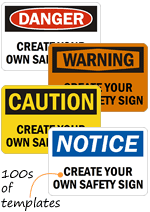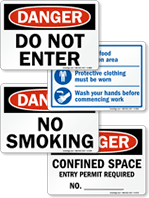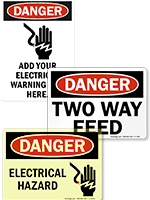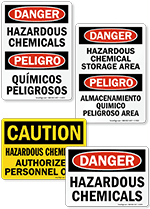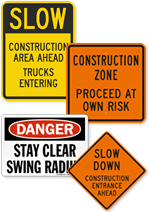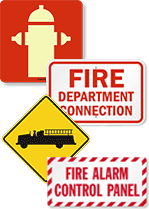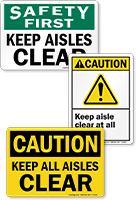The chemical industry’s worldwide revenue stood at $3 to $4 trillion in 2020. This high dependence on chemicals juxtaposes the fact that more and more workers are being exposed to hazardous chemicals across industries daily. The Bureau of Labor Statistics shows a record number of deaths from exposure to harmful substances in 2020, the highest toll since the series began in 2011. According to the OSHA toolkit for workers and employers, 190,000 workers suffer illnesses, and 50,000 die annually from chemical exposures. In fact, exposure to harmful substances or environments is the No. 1 cause of nonfatal injuries and illnesses involving days away from work [National Safety Council].

How do chemicals affect workers?
Hazardous chemicals pose the following hazards to workers handling chemicals -
- - Health hazards - Irritation, sensitization, and carcinogenicity
- - Physical hazards - Flammability, corrosion, and explosibility
Workers may suffer from difficulty in breathing, swallowing, nausea and dizziness, concentration and memory issues, rashes, neurological problems, allergic reactions, and even death.
Is there any federal law that protects workers from being exposed to chemicals at the workplace?
The Occupational Safety and Health Act (OSHA) protects workers against occupational exposure to toxic chemicals. OSHA has multiple standards that regulate chemicals and toxic substances in general industry, maritime, and construction. Employees exposed to chemicals are required to -
- - Have information on hazardous chemicals in their work area (through labeled containers, Safety Data Sheets, etc.)
- - Receive training on how to handle toxic substances.
- - Receive personal protection equipment like eye goggles, apron/lab coat, gloves, closed-toe shoes, respirators, splash shields, and other protective gear.
Apart from OSHA, The U.S. Environmental Protection Agency (EPA) handles various environmental laws that address chemicals, including occupational exposures.
What does OSHA require from employers to reduce occupational chemical exposure?
OSHA guides employers to take the following steps to minimize chemical hazards at the workplace -
- - Elimination/Substitution – Employers need to identify hazards at the workplace and if possible, eliminate the need for hazardous chemical usage or replace it with a less or non-hazardous chemical.
- - Engineering Controls – Employers are required to implement infrastructural and mechanical changes in the workplace to mitigate the risks.
- - Administrative and Work Practice Controls – Employers must change how a task is performed or set up workplace policies, protocols, processes, and control and monitoring mechanisms that reduce occupational chemical exposure of workers.
- - Personal Protective Equipment (PPE): Employers must provide proper PPE that can help reduce the workers' direct contact with hazardous chemicals.
- - Training: Employers must train the employees working around chemicals as required by OSHA standards.
- - Communication: OSHA's Hazard Communication Standard (HCS) requires employers to inform workers about chemical and toxic substance hazards in the workplace using effective chemical Labels, alarms, color-coded systems, chemical information sheets, and other methods.
- - Recordkeeping: Employers need to keep records of chemical injuries and illnesses so that the shortcomings can be rectified in the future. OSHA also provides workers the right to see recordkeeping information such as illness and injury logs, personal health information, and exposure data.
What are employee responsibilities to stay free from chemical exposure?
Just like employers, employees are also responsible for staying safe from chemicals. For instance, Maine laws require employees working with toxic chemicals to:
- - Read the workplace safety and health posters installed at the workplace.
- - Follow all safety regulations set by the employer, and wear or use required PPE.
- - Report hazardous conditions to the employer.
- - Report any job-related injury or illness to the employer, and seek treatment promptly.
In general, employees are expected to have a sense of self-safety like using only labeled chemical containers, using a substance solely for their intended purpose (like not using solvents to clean hands, or gasoline to wipe down equipment), and not eating while handling chemicals, etc. It is assumed that chemical workers do not make silly mistakes like tasting or smelling a substance instead of reading the SDS or taking a sample for analysis first; they must separate incompatibles. Employees must know emergency procedures, emergency equipment, and evacuation procedures. Basic hygiene habits like proper handwashing and cleaning work surfaces are also employees’ duties.
Are employers liable for chemical exposure to workers?
Yes, employers are liable for chemical exposures to their employees. In fact, the General Duty Clause of the OSH Act lays the responsibility of providing a safe and healthful workplace that is free from serious recognized hazards on employers’ shoulders.
What is the penalty for an employer’s negligence towards workplace chemical exposure?
Injuries/accidents resulting from employers’ negligence towards workers using and handling chemicals in the workplace are considered an OSHA violation that may fall into one of the four categories.
- - Willful: Intentional and knowing violation. A penalty of $145,027 for each violation is imposed.
- - Serious: Violation where the employer knew or should have known about a hazard that has the potential to cause death or serious physical harm. A penalty of up to $14,502 is imposed.
- - Other-than-Serious: Violation where the employer knew or should have known that the hazard has a direct relationship to safety and health but probably would not cause death or serious physical harm. A penalty of up to $14,502 is imposed for each violation.
- - Repeated: Violation that is the same or similar to a previous violation. Penalties of up to $145,027 are imposed for each repeated violation.
*The penalty amounts keep changing yearly with the annual inflation adjustment.
Penalties are levied after a workplace inspection which may be conducted after a worker complains to OSHA or an equivalent state agency in state-plan states.
What are OSHA requirements for Chemical labeling and signage?
OSHA’s updated Hazard Communication Standard requires chemical manufacturers and importers to use GHS labels with pictograms, a harmonized signal word, hazard statement for each hazard class and category and precautionary statements, the product identifier, and supplier identification.
Workplace Label requirements have not changed since 1994. OSHA maintains that employers may continue to use the existing signage (including NFPA labels and HMIS labels) to provide employees with hazard information on chemicals. This workplace labeling system may include signs, placards, process sheets, batch tickets, operating procedures, or other such written materials to identify hazardous chemicals. Workplace labels must be in English. Other languages may be added to the label if applicable.
What are the requirements of a chemical hazard pictogram?
The OSHA-compliant chemical hazard pictogram must have -
- - a white background,
- - a red border,
- - a GHS symbol representing a distinct hazard in black,
- - Pictograms shall be in the shape of a square set at a point.

